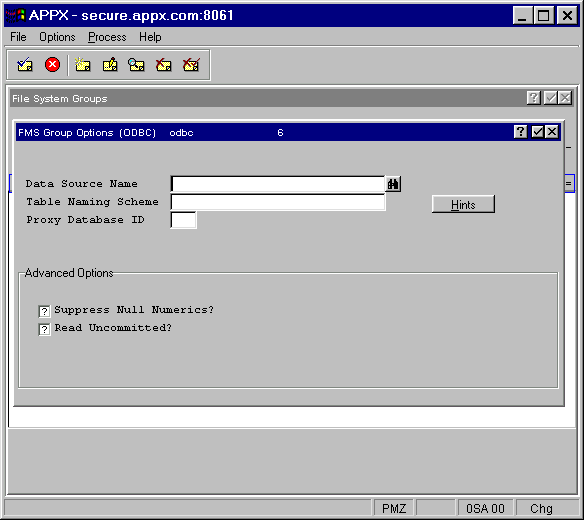
If you select the FMS Group Attributes option in File System Groups File Maintenance for a file system group with FMS type 6, the FMS Controls overlay for ODBC appears as shown in Figure 2-21 below.

Figure 2-21. FMS Controls Overlay for ODBC (Type 6)
The ODBC overlay contains these fields:
· Data Source Name defines the particular ODBC source being used. For example, Microsoft Access is an ODBC data source.
· Table Naming Scheme assists APPX in translating its 8-character file names to the ODBC source’s external table names. If users will be accessing the ODBC source at the File System Group level, then a “Table Naming Scheme” is entered here. Select the Hints option for help on constructing a table-naming scheme. See the Table Naming Scheme Hints section for an example of the Hints overlay. If you intend to override these parameters at the file level in Database Management, then you can leave this field blank and enter an explicit table name there.
· Proxy Database ID identifies the APPX Database ID.
· Suppress Null Numerics? determines whether or not to disable the null numeric feature inherent in the database; answer "yes" ![]() if you want to be consistent with APPXIO behavior which does not have this capability (a zero entry cannot be distinguished from a null value in APPXIO).
if you want to be consistent with APPXIO behavior which does not have this capability (a zero entry cannot be distinguished from a null value in APPXIO).
· Read Uncommitted? determines whether or not to read a record with an update pending which has not yet been committed; "no" ![]() is recommended in order to emulate APPXIO behavior.
is recommended in order to emulate APPXIO behavior.
Note: APPX does not support fields (or records) longer than 32,767 (32K) characters. If you map an APPX file to a pre-existing RDBMS table, you may find that the table includes a column larger than 32K; such columns are often referred to as memo columns. APPX offers limited support for memo columns. You can access a memo column by defining (in the APPX data dictionary) an ALPHA X(n) field in the corresponding position.
When you read a record that includes a memo column, APPX will only read the first n characters and will truncate any remaining data. If you read a record with hold and APPX would have to truncate a memo field, the read will fail. Reading a record with hold implies that you may try to update the record and APPX will try to prevent you from losing data through truncation. If you need to delete a record that would include truncated data, use partial-record I/O to avoid truncation. You can also use partial-record I/O to update other fields in the record. In general, you should avoid reading memo columns except in those cases where you actually need the data.